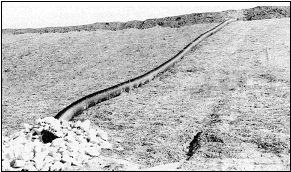 |
 |
To Print Use The pdf File
ILLINOIS URBAN MANUAL
PRACTICE STANDARD
TEMPORARY SLOPE DRAIN
(no.)
CODE 970
 (Source: IN Handbook for Erosion Control on Developing Areas) |
DEFINITION
A flexible tubing or rigid conduit extending temporarily from the top to the bottom of a cut or fill slope.
PURPOSE
The purpose of this practice is to convey concentrated runoff down the face of a cut or fill slope without causing erosion on or below the slope.
CONDITIONS WHERE PRACTICE APPLIES
This practice applies to construction areas where stormwater runoff above a cut or fill slope will cause erosion if allowed to flow over the slope. Temporary slope drains are generally used in conjunction with temporary diversions or diversion dikes to convey runoff down a slope until permanent water disposal measures can be installed. The maximum allowable drainage area is 5 acres per slope drain.
CRITERIA
Capacity - Peak runoff from the 10-year frequency, 24-hour duration storm.
Dike design - An earthen dike, meeting the requirements of practice standards TEMPORARY DIVERSION 955 or DIVERSION DIKE 820, shall be used to direct stormwater runoff into the temporary slope drain.
Pipe size - Unless individually designed, size drains according to the following table:
| Pipe/Tubing Diameter (D) | Max. Drainage Area |
|---|---|
| 12 inches | 0.5 acres |
| 18 inches | 1.5 acres |
| 21 inches | 2.5 acres |
| 24 inches | 3.5 acres |
| 30 inches | 5.0 acres |
Inlet - The height of the earth dike at the entrance to the pipe slope drain shall be equal to or greater than the diameter of the pipe, D + 18 inches and at least 6 inches higher than the adjoining ridge on either side. The lowest point of the ridge should be a minimum of 1 foot above the top of the drain so that design flow can freely enter the pipe. The minimum top width of the dike at the inlet shall be 4 feet. The inlet may be a standard IDOT flared end section with a minimum 6-inch toe plate. A standard T-section fitting may also be used. All connections shall be watertight. Appropriate inlet protection shall be used if a sediment trapping facility is impractical downstream. If ponding will cause a problem at the inlet and make such protection impractical, appropriate sediment removing measures shall be taken at the outlet of the pipe.
Outlet - The pipe slope drain shall outlet into a sediment-trapping device when the drainage area is disturbed. A riprap apron meeting the requirements of practice standard ROCK OUTLET PROTECTION 910 shall be installed below the pipe outlet where water is being discharged into a stabilized area.
Conduit - The conduit shall have a slope of 3 percent or steeper and be installed with watertight connecting bands. The conduit material may be smooth iron; corrugated metal or heavy duty non-perforated corrugated plastic pipe or specially designed flexible tubing.
Install reinforced, hold-down grommets or stakes to anchor the conduit at intervals not to exceed 10 ft with the outlet end securely fastened in place. The conduit must extend beyond the toe of the slope. Terminate the drain in a 4-foot level section where practical.
CONSIDERATIONS
There is often a significant lag between the time a cut or fill is graded and the time it is permanently stabilized. During this period, the slope is very vulnerable to erosion, and temporary slope drains together with temporary diversions can provide valuable protection.
Temporary slope drains must be sized, installed, and maintained properly, because failure will usually result in severe erosion of the slope. The entrance section to the drain should be well entrenched and stable so that surface water can enter freely. The drain should extend downslope beyond the toe of the slope to a stable area or outlet.
Other points of concern are failure from overtopping from inadequate pipe inlet capacity or blockage and lack of maintenance of diversion channel capacity and ridge height.
PLANS AND SPECIFICATIONS
Plans and specifications for installing temporary slope drains shall be in keeping with this standard and shall describe the requirements for applying the practice to achieve its intended purpose. At a minimum include the following items:
All plans shall include the installation, inspection, and maintenance schedules with the responsible party identified.
Standard drawing IL-670 TEMPORARY SLOPE DRAIN PLAN may be used as a plan sheet.
OPERATION AND MAINTENANCE
Inspect the slope drain and supporting diversion once a week and after every rainfall and promptly make necessary repairs. The contractor should avoid the placement of any material on and prevent construction traffic across the slope drain. When the protected area has been permanently stabilized, temporary measures may be removed, materials disposed of properly, and all disturbed areas stabilized appropriately.
NRCS IL August 1994